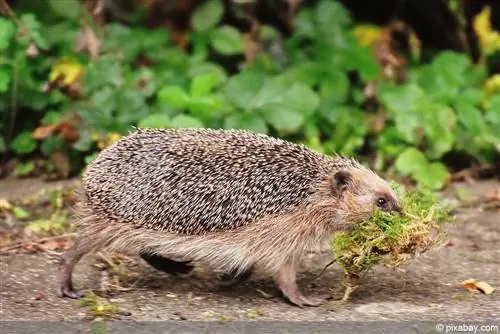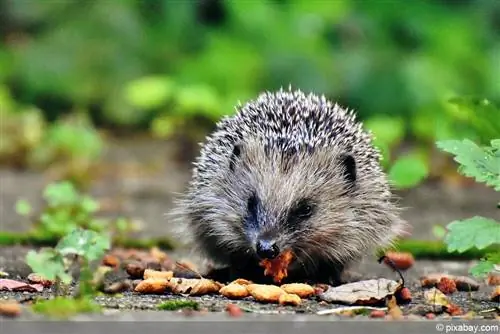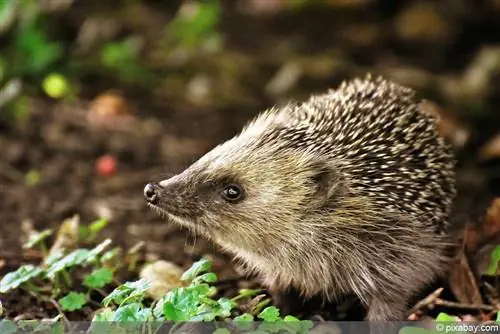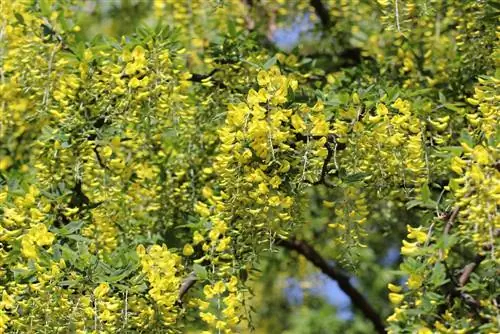- Author admin [email protected].
- Public 2023-12-17 03:39.
- Last modified 2025-06-01 06:48.
If you feel a touch of envy at the thought of “hibernation”, you will be relieved of it after reading this article - hibernation is a highly strenuous and complicated matter for the hedgehog, with preparation, waking up in between, many specially adapted ones metabolic processes and so on. Because a lot can go wrong during the procedures associated with hibernation, there are hedgehog hibernation stations, but not every hedgehog that appears to be too light can simply be transported to them quickly. That's why it's an advantage if animal-loving people know a little more about hedgehog hibernation:
Why does the hedgehog sleep through the winter?
Stupid question, the summer sun and beach freaks among the readers will say. But hibernation isn't as simple as making your bed in the evening, lying down in it and pulling the blanket over your head. But a complicated process that can best be summarized under the heading “smart energy management”.
The hedgehog's spiked coat gives it an advantage when it comes to defending itself against enemies, but this comes at the price of a crucial disadvantage: It's not a spiked "dress", not even a thin summer flag with an unusual design; Even in summer, the hedgehog uses a lot of metabolic heat to keep its body temperature stable at around 34° C due to the poor thermal insulation of the back. From autumn onwards, the food supply that can be reached without effort decreases, the hedgehog becomes thinner and has even more difficulty regulating its body temperature. Insulating the back, which is well supplied with nerves and supplied with blood to raise the spines, is only better with a thick layer of fat, which in turn makes it very difficult to search for food/hunt - the logical solution to this problem is for the hedgehog to stop eating and simply goes to sleep.
There are some animals that go to rest in winter, e.g. E.g. brown bears, badgers, squirrels, some bats, raccoon dogs and raccoons. In response to unfavorable external conditions or the limited food supply in winter, they also severely limit their energy requirements, but maintain their body temperature like a kind of long sleep and wake up several times in winter. To look for prey, collect new supplies or eat up the supplies built up in the summer (typical tragic moments in the life of a squirrel: they have once again forgotten where they stashed something).
The hibernation of hedgehogs (and most bats, hazel mice, marmots and dormice) demands more from the metabolism than mere hibernation:
- The body temperature adapts to the low ambient temperature
- The warm-blooded animals temporarily become cold-blooded animals (for them, however, hibernation is called cold paralysis)
- The heart, which beats around 200 times per minute in summer, only beats 2-12 times per minute
- In the summer, the hedgehog takes in air about 50 times per minute, while in hibernation it takes 13 breaths per minute
- Several body organs work on a slower burner, which, for example, causes blood sugar levels to drop drastically
- But they work, even if you eat your own fat, metabolic products are produced that would actually be excreted every day
- These products from the liver, kidneys, intestines, etc. accumulate in the lower part of the intestine in winter and are discarded immediately after awakening
- In an emergency, fine control ensures that the hedgehog does not freeze to death in its sleep
- From around 5°C outside temperature downwards, the hedgehog's body produces heat to maintain the vital minimum temperature
- The hedgehog naturally spends its hibernation curled up into an “impregnable spiked ball”
- That's why his sensory organs can switch off and he hardly reacts to mechanical stimuli anymore
Overall, the hedgehog slows down its metabolic processes to an incredibly low rate: With 1 to 5% of its output in the active state, the hedgehog spends an average of five months of the food-poor, cold season sleeping and wakes up in the spring emaciated but well rested.
Requirements for a restful hibernation
So that the long hibernation does not harm the hedgehog's constitution, some preparation is needed:
- In the summer, the hedgehog has to eat up a fat pad of sufficient thickness that can feed it for months
- The average adult hedgehog ideally goes into the winter weighing more than 1,500 grams
- If the fat reserves are used up in spring, in extreme cases the hedgehog weighs no more than 350 grams
- Over the warm season, this hedgehog gained a good 400%
- That would mean a 50 kg woman would have to weigh 200 kg at the end of the summer; An achievement even for Cola fans
- Shortly before reaching the optimal weight, the winter quarters have to be set up
- The hedgehog looks for a place that is somewhat protected from the cold, such as a hollow tree trunk, a cave in the ground, etc.
- It is padded with hair and leaves, hay and straw until the insulation is right
- When the hedgehog has completed the “culinary” achievement and the construction work, the bells are already ringing in the direction of hibernation
- The male hedgehogs go to sleep first, often at the beginning of October
- Then the female hedgehogs, who first have to gain weight after the strenuous rearing of the young
- Shortly before the cold becomes threatening, the young hedgehogs go to sleep
- These mini hedgehogs first had to grow to a reasonable hibernation weight
Tip:
The best hibernation aid for a hedgehog is not human-supervised hibernation (more on that below), which, as always with wild animals, should be reserved for emergencies. But rather a garden design that makes it easy for hedgehogs to find or equip themselves with suitable winter shelter. This nature conservation in the garden is more important than ever today, because given the current, not very natural state of our agriculture, our gardens are one of the most important habitats for hedgehogs. What “your garden has to offer” so that a hedgehog enjoys spending the winter with you is explained at www.nabu.de/umwelt-und-projekte/oekologi-leben/balkon-und-garten/naturschutz-im-garten/00755.html marked.
What triggers hibernation?
Which influences cause the hedgehog to “go to sleep on October 17th at 6:30 p.m.” have not yet been researched in detail. The declining food supply plays a role, as does the decreasing length of daylight and falling temperatures. But they probably only trigger a kind of "readiness for hibernation", at the same time a hormonal change starts in the hedgehog's body: the decreasing exposure to ultraviolet light from the weakening sun reduces the body's own vitamin D production, which triggers the production of so-called freezing hormones should.

In addition, according to experts, hedgehogs have an internal clock that gives the animals a seasonal rhythm. It determines when the time has come for fat deposits to form; As the fat deposits grow, the willingness to sleep and to set up a sleeping cave also increases; The narcotic influence of the higher carbon dioxide concentration in these sleeping caves may then be the initial signal for hibernation. As I said, everything hasn't been fully researched yet, but the start of hibernation cannot be determined simply by time or temperature. When the time comes, the hedgehog needs about 5 to 6 hours until its metabolism “slows down for hibernation.”
Winter sleep duration and wake-up procedure
Hedgehogs hibernate for between four and six months, depending on the climate, age, physical condition and condition of the sleeping cave. Usually not continuously, only bats do the work (whose hibernation quarters high up in a church tower or in a cave also guarantee maximum privacy), but the normal breaks are usually rather short. Sometimes the hedgehogs wake up but stay in the nest and go back to sleep shortly afterwards; sometimes they leave their nest and are active for a few days. We don't yet know exactly why this happens; the cause is currently thought to be a kind of "reset"; The massively reduced metabolism is (to be on the safe side?) reset to normal values every now and then.
Awakening followed by leaving the nest is usually observed when temperatures outside are around 10°C or higher for a long period of time. Like falling asleep, waking up takes several hours, but unlike falling asleep, it requires enormous energy consumption. During sleep, mainly white back fat is used up; the hedgehog has stored special brown fat in the shoulder area for the strenuous waking process.
During this awakening, blood circulation increases to five times the hibernation values, heart and breathing rates accelerate greatly, and the muscles (especially those of the legs) tremble violently. By the time this wake-up phase heralds spring, the hedgehog has lost an average of 30% of its body weight. Its first activities are therefore understandably dedicated to searching for food, and immediately afterwards it is about reproduction so that the offspring are large enough for the next hibernation.
Winter help for hedgehogs - not an easy decision
The hedgehog only sleeps through around five months of the cold season and wakes up well-rested in the spring if everything went well during hibernation. As is the case in life, a lot can go wrong with such a complicated procedure as hibernation.
The search for a rotten tree or a cave to build a magnificent sleeping cave can be unsuccessful, a tree can be too rotten and break apart with the cave half built, the earth cave that has been identified as suitable collapses in the middle of the build, every person, Anyone who has ever built a house can continue this list endlessly with a little imagination.
The hedgehogs may have started breeding too late; Of the parents, this only affects the female, who is now struggling to gain enough winter weight (“Papa Hedgehog” goes to sleep early, unmoved). The birth late in the year becomes really problematic for the young hedgehogs, who need time to grow and gain winter fat; By the beginning of November, the young hedgehog should have gained at least 500 grams so that it can survive its first hibernation on its own.
Young hedgehogs who do not make it in time are the normal guests of the hedgehog stations; But injuries that heal too slowly can also mean that a hedgehog cannot reach a sufficient hibernation weight.
However, the most important thing when it comes to “human help for hedgehogs” is not to immediately pack up every hedgehog who may be too light and take them to hedgehog help. On the contrary, you should not get too close to the hedgehog at all unless you are sure that this is urgently necessary due to serious injuries. Even then, if possible, it is not the turn of the hedgehog newbie, but rather expert help should be sought.
Always remember:
Animal children who are still cared for by their mothers may no longer be accepted by their mothers after human contact and then starve miserably.
You can still do a lot to help the hedgehogs in your area, and the preparation for this help is already in the summer or autumn. Make your garden as “hedgehog-friendly” as you can without too much effort following the suggestions in the link above. Find out where the nearest hedgehog station is near you. Find out whether and how you can make hibernation easier for the hedgehogs in your area by feeding them in autumn; and when it is appropriate to provide help to an obviously malnourished hedgehog child or to take him into care over the winter (and what steps should be taken/considered in the current case).

In general, young hedgehogs need human help if they cannot reach a minimum weight of around 500 to 600 g shortly before the onset of winter; an adult hedgehog weighs between 1000 and 1400 g (depending on age and size) “too easy to go to sleep”. But assessing this weight is not that easy, and it is certainly not easy to get it to the right sleeping weight under human supervision. And then there are numerous details to consider when caring for a hedgehog in the winter, from the correct sleeping quarters (and its location), to feeding and checking in the winter quarters, to taking care of the awakening/preparation for release into the wild.
Conclusion
It's not just hedgehogs that need help over the winter these days, but also birds and especially the insects, which have declined so dramatically, can use support in the cold season. Please inform here in advance so that bird food or insect hotel really offers the best possible help and only causes you very little work; In addition, there are sometimes “problem children in the region” who need more help than other types.






